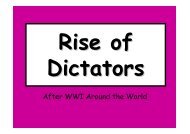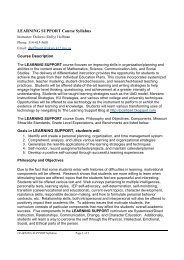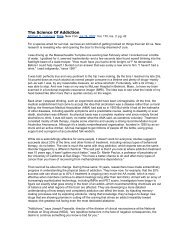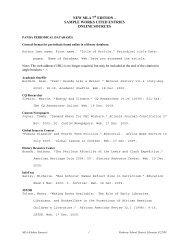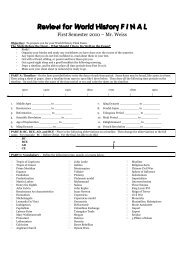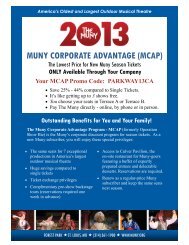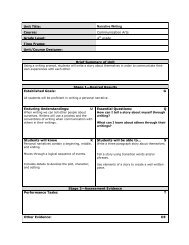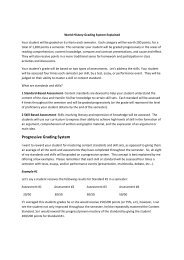Unit 4 Test_19_22
Unit 4 Test_19_22
Unit 4 Test_19_22
You also want an ePaper? Increase the reach of your titles
YUMPU automatically turns print PDFs into web optimized ePapers that Google loves.
5) How successful was the Portuguese monopoly on Asian products?<br />
A) The Portuguese monopoly was rigidly enforced over Asian products for almost two centuries.<br />
B) Though they managed to monopolize some spices grown in limited locales, the Portuguese<br />
lacked the manpower and ships to sustain a monopoly.<br />
C) The Portuguese were unable to achieve control over any Asian products due to competition<br />
from the Chinese commercial navy.<br />
D) For some decades they were able to maintain a complete monopoly over Asian products<br />
shipped to Europe.<br />
E) Other European trade powers were frozen out of the market due to the success of the<br />
Portuguese establishing fortified trade ports.<br />
6) What was the African contribution to the "Colombian Exchange"?<br />
A) Potatoes<br />
B) Tapioca<br />
C) Manioc<br />
D) Slaves<br />
E) Large mammals<br />
7) In terms of literature, what was the chief accomplishment of the Ming era?<br />
A) Poetry<br />
B) The novel<br />
C) Haiku<br />
D) Narrative history<br />
E) The short story<br />
8) How did the profitability of the slave trade compare to that of other contemporary business<br />
ventures?<br />
A) The slave trade was less profitable in the Sahara trade but extremely profitable for the Atlantic<br />
slave traders.<br />
B) Profits from the slave trade in the 18th century were so lucrative that capital derived from the<br />
trade in human beings was used to capitalize the European Industrial Revolution.<br />
C) The slave trade was less profitable on the whole than other business ventures because of the<br />
high costs and risks involved.<br />
D) The slave trade became increasingly dangerous and risky, so that by the 18th century its<br />
returns were minimal and most participants were bankrupted.<br />
E) The slave trade was little more profitable than most business activities of the age and was not a<br />
major source for the Industrial Revolution of Europe.<br />
5)<br />
6)<br />
7)<br />
8)<br />
2



